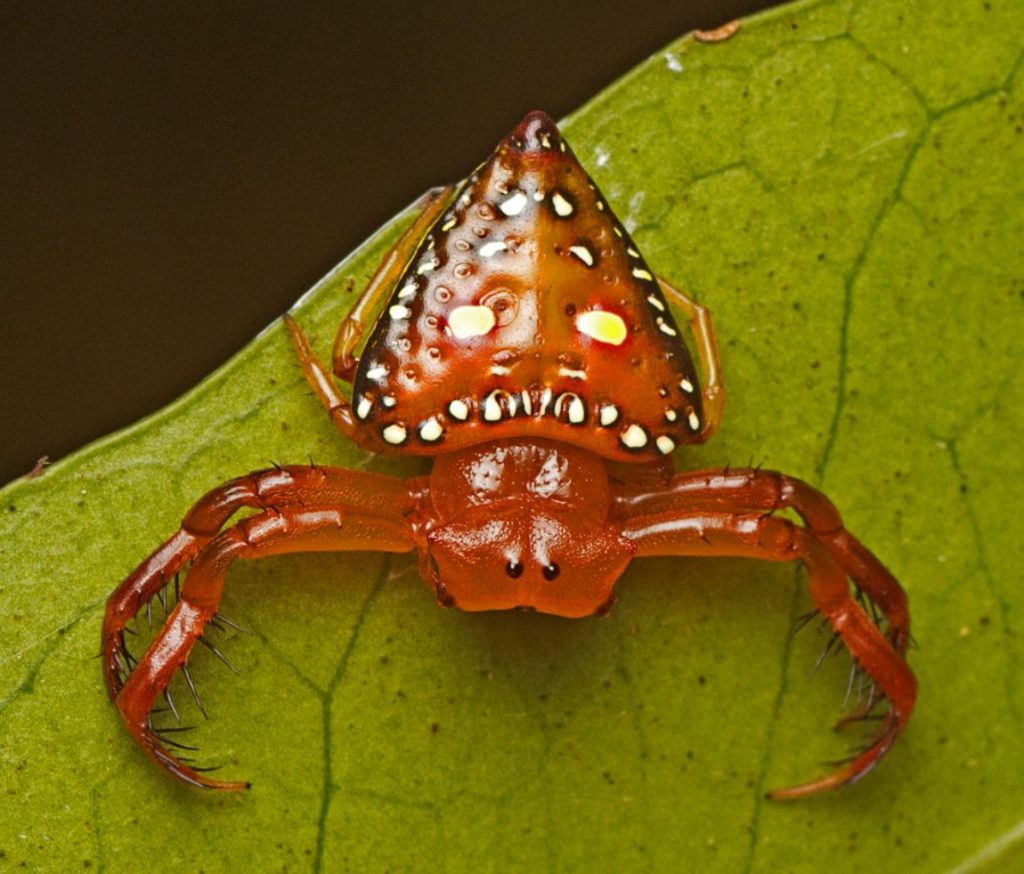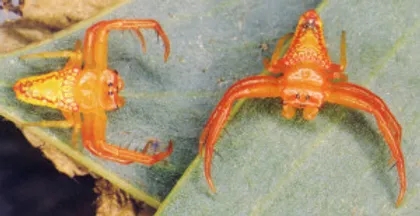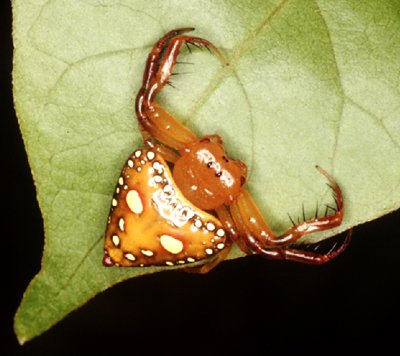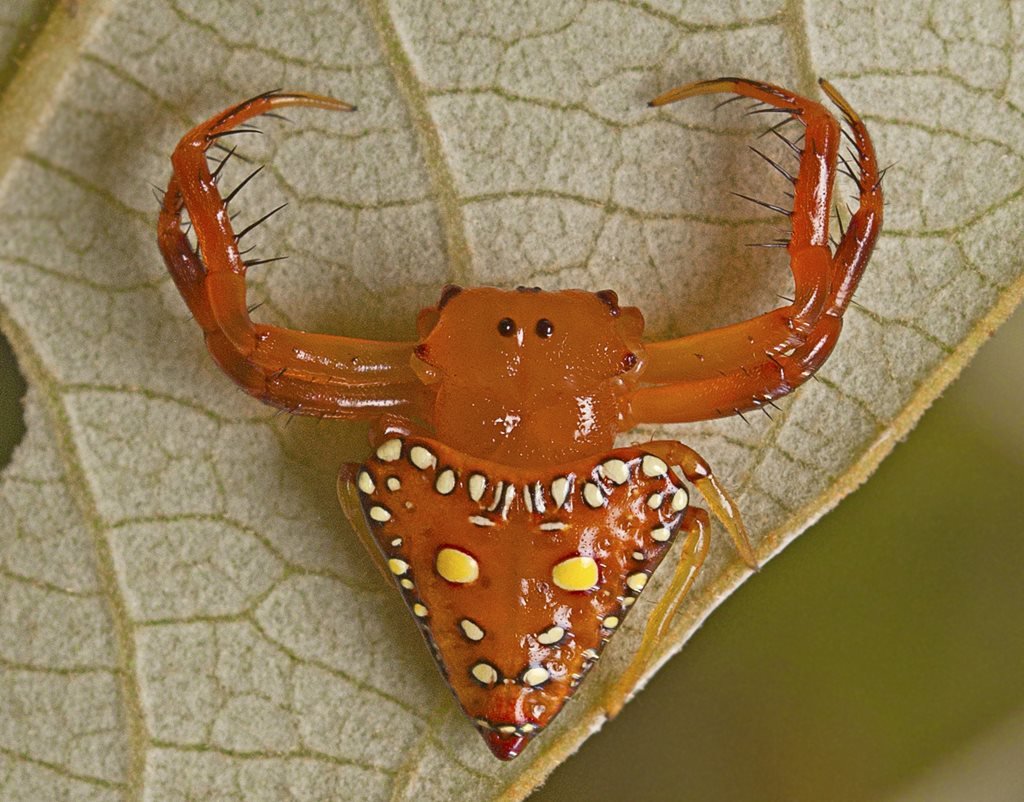Triangular spiders are brightly coloured, distinctive spiders. Their unusually shaped and brilliantly coloured and patterned abdomens make them stand out from the crowd.Arkys lancearius, the triangular spider, is a common Australian spider belonging to the family Arkyidae.It is an ambush hunter, commonly found resting on leaves and ferns or hanging from just a few threads of silk. The front two pairs of legs are large, suited for grabbing small insects, while the rear pairs of legs are much smaller.

These small spiders come in a variety of bizarre geometric, spiky or lumpy shapes, including triangles. Their front legs have long spines on the inside edge used to ambush prey. They don’t build webs, instead, they sit and wait for prey to venture within striking distance then rapidly lunge and grab it.
Identification
As their common name suggests they have a very distinctive triangular or heart-shaped abdomen that is often brightly coloured and patterned in a combination of red, yellow, orange, black or white. Their first two pairs of legs are enlarged, covered in spines and held curving forward to catch prey. The last two pairs of legs are much shorter in comparison.

Males and females are very similar in colour, but males usually have a narrower abdomen than their respective females and slightly smaller size.
Triangular spiders have been placed in several different families since their original description, including Araneidae, Mimetidae and Tetragnathidae. Since 2017 they have been placed in the family Arkyidae along with one other small genus. Arkys was sometimes previously spelled with a ‘c’ instead of a ‘k’ but this spelling is no longer used.
Not all species in the genus Arkys are the brightly coloured triangular spiders. Some other species in this genus mimic bird droppings in size, colour and shape.

Prey:
Triangular Spiders feed on small insects such as grasshoppers, flies, caterpillars and ants. They sit very still anchored by its hind legs. When anything touches its front legs, they close like a pair of tongs.
Breeding:
After the male and female mate, the female can lay up to 50 eggs. The egg sac is a pale coloured silk ball about 7mm across which is hung on a stalk.
Venom:
Triangular Spiders have small fangs. They can only hurt small insects and are harmless to humans. They can kill an insect in 13 seconds. If a human is bitten, they will feel mild local pain for about 30 minutes; then it forms a red welt which feels hot.
Habitat
Triangular spiders are found in a range of habitats throughout Australia, in particular the east coast of Australia. They are commonly found in eucalypt forests and woodlands, but can be found in gardens. They are often seen on trees, shrubs and on or under leaves.Triangular spiders are also commonly found on plant regrowth after forest fires.
Australia has about 9 species of Triangular Spiders, which ambush insects. The Triangular Spiders Latin name is Arkys Lancearias. Its full size is about the size of a twenty cent piece.
The abdomen is small and flat. It is shaped from a triangular shape to a heart shape with white circles. The front legs are strong with spines. They also have spines sticking out sideways on their head. They can be coloured red, orange, brown, black, white and yellow.
Triangular Spiders live in gardens, trees, shrubs and on clothes lines. They are most common in Summer. They live Australia wide in the warmer regions. They also live in New Guinea.
The most common Triangular Spider lives in the rainforests, bushland and many different places such as leaves, seed heads and flower spikes. They live in all eastern states and favour areas of regrowth in the bush after bushfires, where thay can blend in with the colours of the bark.

Distribution
Triangular spiders are found through out the Australasian region including Australia, Papua New Guinea, Indonesia and New Caledonia.
Feeding and diet
Triangular spiders ambush their prey. They wait motionless, usually on the underside of leaves with their front two pairs of legs widely separated. When their prey passes by they capture it. Their sit and wait prey capture behaviour is similar to how flower spiders catch their prey.
Triangular spiders feed on insects, mainly flies.
Other behaviours and adaptations
Whilst triangular spiders are usually found on the underside of leaves by day, at night they are often seen moving along a silk line between leaves or hanging on a few lines with legs outspread.
Triangular spiders do not catch prey in webs, they use their silk for their egg sacs, for silk lines and holding on to leaves. They dab silk onto the leaf and are attached through the spinnerets as well as several legs.
